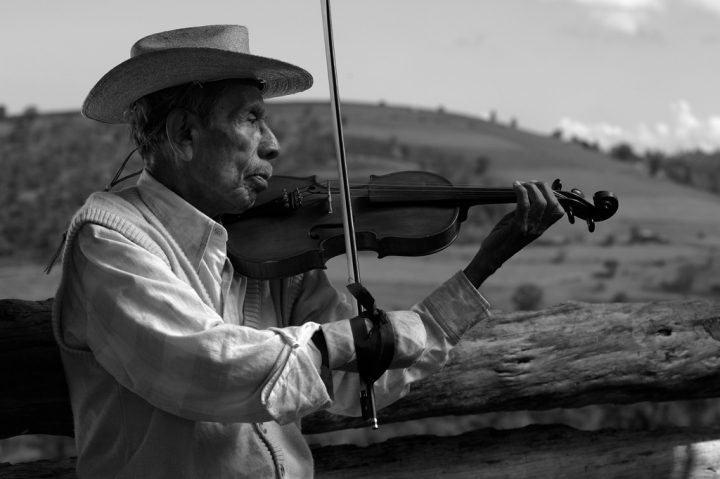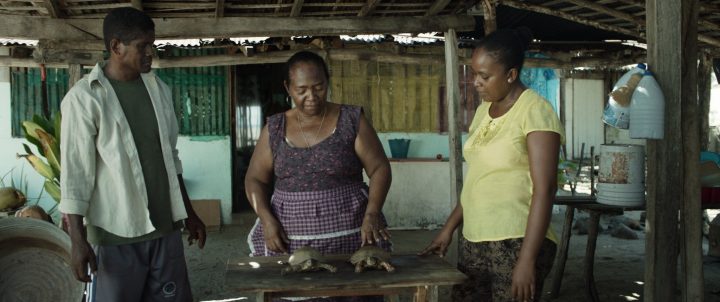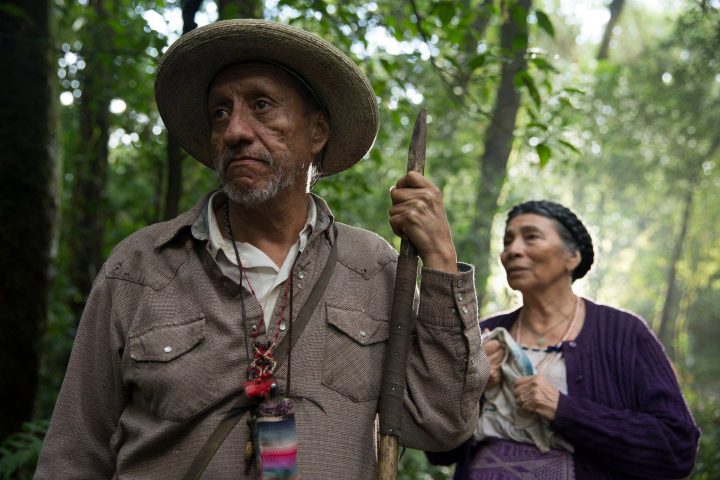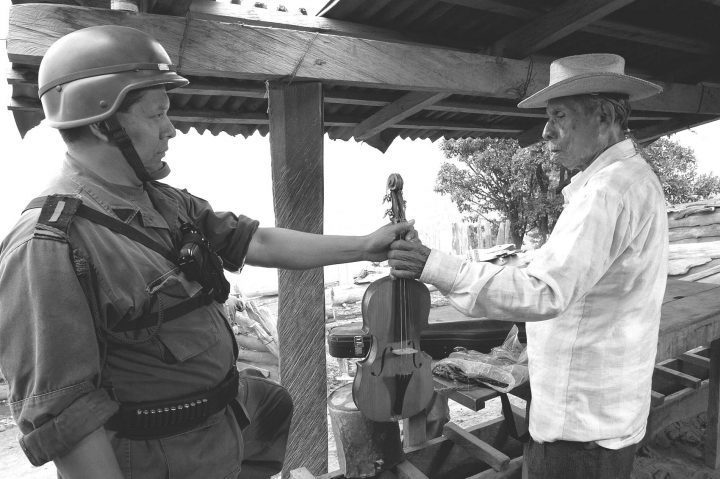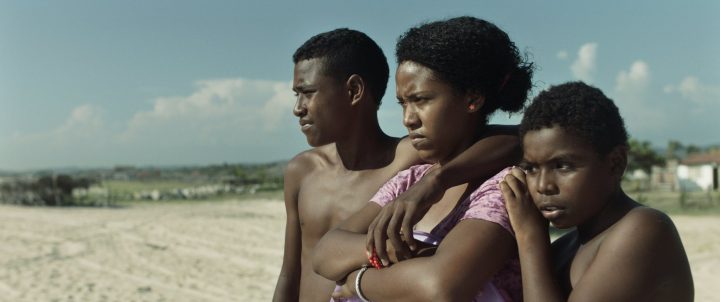Commentary on La Negrada, Sueño en Otro Idioma and El Violín
[Note: References to film portrayals of Indigenous dramas from the golden age of Mexican cinema have not been included because they depict a folkloric and at times disrespectful view that does not reflect the cultural diversity of Mexico’s First Nations.]
In 2018, two fictional films about First Nations peoples and marginalization were screened, albeit briefly, in commercial movie theatres in Mexico. Both were produced as independent films, different from commercial and fringe productions.
Winners of national and international awards, both films address fundamental questions that relate to the identity of First Nations in Mexico and their marginalization.[1]
The wire fence featured in the 2002 film Rabbit-Proof Fence about the creation of Australia as a nation clearly symbolized that the way to build the country was to keep out what was different. The fence, in the case of Mexico, takes on other forms and expressions that also lead to marginalization or exclusion: cultural walls, officially sanctioned myths and legends, geographic separation and discrimination, and deep economic differences. All these play a role in defining the exclusionary map of the so-called “Mexican nation.”
La Negrada (directed by Jorge Pérez Solano, 1964) tells the story of a community that could be anywhere in the Caribbean, Central America or Colombia. The audience is drawn into a place that has no clear geographic location. This is the first fictional film about an African-Mexican community, and few know that these communities even exist. After exhaustive scouting along the coast of Oaxaca and other Mexican states, the director chose his cast from among non-professional actors. Throughout the film, which depicts the customs and daily lives of people in the community, their marginalization is revealed gradually and through compelling images: a refrigerator being transported in a small boat, trucks used as public transportation, the lack of cars on the streets, the plain houses and simple forms of dress.
The camera of César Gutiérrez (winner of an Ariel, a Mexican film industry award) captures the beauty and simplicity of Corralero, a rural community that actually does exist on the Oaxaca coast, as well as the city of Pinotepa Nacional and the sanctuary of Juquila. Set against a backdrop of a barely developed tropical town, the cinematography reveals the slower pace of rural communities far from the urban centres, and the beauty of the film’s characters. Different aspects of the local culture are subtly disclosed, peppered with popular verses that make reference to the locals’ way of speaking and origins. Although shot as a drama, the film takes a light approach with many humorous touches, and the dialogue sometimes employs crude language, in jest or otherwise. Some critics have gone so far as to label the film as racist:
“¡Hasta que trabajas, negro!” (“Now you’re working, negro!”), Alicia laughs as Neri carries in the refrigerator he’s brought as a gift, or when she recites: “Si por negra me desprecian, no desprecies mi color, que entre perlas y diamantes, esta negra es la mejor, ¡ay, ay, ay!” (“If I’m despised because I’m black, don’t despise my colour, for when it comes to pearls and diamonds, black is the best, yes, yes, yes!”)
“Hay mexicanos que nadie ve” (there are Mexicans that nobody sees), says the trailer’s tag line, and that is exactly the feeling you walk away with from this film — of having found out about something that the official history of Mexico hadn’t told. It was the express intention of the director to shine a light on the existence of these forgotten communities. As he explains in various interviews online, there are no film directors of African descent in Mexico, and the few known black actors are not of Mexican origin.
Sueño en Otro Idioma (I dream in another language), directed by Ernesto Contreras, 1969) revolves around a native language related to some of the peoples who inhabited and continue to inhabit the territory known today as Mexico. Winner of the Sundance Audience Award and 16 Ariels including best picture, cinematography and original score, the film shows how local languages — and any language for that matter — depend on their speakers, and represent much more than a means of communication.
The film addresses other equally complex questions having to do with identity, religion, marginalization, sexuality, even the economy, and their relationship to language. The story begins when someone (a linguist) from outside the community arrives and attempts to rescue the local language, Zikril, working with a couple of elderly people who are the only ones who can still speak it.
More questions than answers
The two films offer much more than audiences expect and certainly more than the stories themselves. I won’t disclose further details about the storyline, which is best seen on screen, but I will talk about how these films are important in raising questions about social and historical identity – and about the creation of the identity components of the nation state that, in its construction over two centuries, has marginalized cultures to the point where many have already disappeared and others may soon be lost.
First, La Negrada makes us think about racism and, from there, identity. What does it mean to be Mexican? What defines the citizens of a country, or is there something that should define them? Does skin colour have anything to do with nationality or with the national ideal, or with belonging to a social group or a country? And, in which social strata does this place (and sometimes relegate) people?
Historian Federico Navarrete uses the term racismo cromático in his book, México racista, una denuncia[2] (Mexico, Grijalbo, 2016), to refer to discrimination based on skin colour, and to demystify prevailing conceptions about Mexico, particularly in regard to the mestizaje myth. (According to the myth, the “bronze race” was created out of the mix between Spanish and indigenous peoples dating back to the 16th century. In reality, however, this mix did not actually include the majority of the population, whether in the 19th, the 20th or the 21st century.[3]) Navarrete defines mestizaje as an ideological legend that has led, among other things, to the denial of the existence of racism in this country. Far from having been eradicated, racism has taken on new forms, and “being white” (including a lifestyle where certain European and US values predominate) continues to be a widely held aspiration.
In the national context, the denial of racism finds its most glaring example in regard to Mexico’s black communities: “[…] the invisibility of the Afro-Mexicans or Mexicans of African descent […] is [entrenched] to such an extreme that they are denied recognition of their nationality and their citizenship,” Navarrete explains,[4] referring to a CNN news item from 2011 that reported on how Mexican citizens of African descent were deported when they could not prove their citizenship to the immigration authorities. La Negrada portrays this in a tense scene between a female character and immigration officials.
Few know that Mexicans of African descent have lived in Mexico since the 16th century, when they were brought as slaves by the Spanish. According to data (2017) from the Instituto Nacional de Estadística y Geografía (INEGI – the Mexican Institute of Statistics and Geography), African-Mexicans make up 1% of the country’s total population today and live mainly in the coastal regions of the states of Guerrero, Oaxaca, Veracruz, and in the central state of Mexico and Baja California Sur.
In Sueño en otro idioma, there is a “mysticism associated with language,” a unique way of seeing and experiencing the world through knowledge and artistic expression such as music. In the film, it is clear that preventing the disappearance of the Zikril language would mean navigating against the forces of the market and the dominant culture, which reach this community through the radio. The emotional ties that the language generates seem to have no reason for continuing except for the relationship between the two elderly people who speak it.
In order to clearly reflect the place that language holds in a person’s identity, the director, Ernesto Contreras, hired a linguist, Javier Valdés, to create a language instead of using any of the 68 Indigenous languages spoken in Mexico. Many of these are spoken by only a few dozen people and are in imminent danger of becoming extinct.[5] In fact, the idea of the film arose from a newspaper article about the last two speakers of an Indigenous language in the state of Tabasco. The film director has spoken about the invention of the Zikril language in many interviews (Vice magazine devoted an article to it) and of how bringing it to the screen posed a monumental task of creating the language, preparing a dictionary, teaching it, learning it, practicing it and speaking it.
The idea of inventing a language and not using an already existing one stemmed from recognition of the sacred place that a language holds among its speakers, as Contreras expressed in an interview. He didn’t want to be seen as taking advantage of a language that is becoming extinct. And clearly, the people who speak these languages are in marginalized communities that are also experiencing the loss of their traditional form of expression.
Once again, complex questions arise: What defines identity or how is it defined? How do we look at the world? How do we comprehend and learn from it? What is the relationship between a language and one’s country of citizenship, particularly if the language goes unrecognized or is forgotten? How is the immediate sense of belonging defined? Does loyalty to the identity of a community precede the identity of the nation state? Can the two identities co-exist or do they contradict each other? And finally, who has the right to narrate local history where identity, regardless of its origin, is at the forefront?
These questions are directly relevant to at least 70 First Nations who speak 68 languages and are located throughout Mexico, according to the Atlas of First Nations Peoples in Mexico. And we also know that their marginalization is identified by the barriers of discrimination constructed centuries ago, following the Spanish conquest in the 16th century.
The Mexican and nationalist component of this marginalization is more recent, and can be traced to the rise of the nation state, the Declaration of Independence in 1810, and the construction of the mestizaje ideology by intellectuals (Justo Sierra and more clearly, José Vasconcelos) around the turn of the 20th century. The dominance of nationalist Mexican ideology has been so powerful and all pervasive that very little has been questioned.
These questions are relevant to all who inhabit the country and are therefore immersed in this ideology that shapes the identity of so many, despite the fact that it has not always existed and may not exist in the future. For First Nations peoples, it has been imposed from the outside and is not part of their own identity.
Yásnaya Aguilar,[6] an El Colegio de México academic, has delved into these complex topics surrounding the nation state in Mexico. Of Mixe origin (from a mountain community in Oaxaca), Aguilar talks about how she grew up and went to school in a Mixe community, and spoke in her mother tongue. It wasn’t until she got to high school in Mexico City that she found out she carried the label of “Indigenous” in addition to being “Mexican.” This triggered an identity crisis that led Aguilar to focus her studies on the formation of the nation state:
Today, nation states are held up as one of the monopolizing entities in generating discourse on identity and its symbols. They establish a hierarchy for differences, determine a set of traits accepted as the norm and against which others are measured. These traits are related to symbols, music, dance, history, folklore and cuisine. The contrast between traits is naturally symmetrical, but nation states prioritize them, selecting a simplified set of traits, which in our case are called the “Mexican identity.”[7]
The Mexican identity with its mestizo ideology belied by racist actions and power structures marginalizes and excludes those who do not adhere to it. In this sense, the Mexican mestizaje myth can be equated with the US melting pot. The discourse doesn’t reflect the reality: instead of mixing together, the various “ingredients” (to continue the metaphor) remain separate.
On the fringe – other productions
Besides these two independent films, there is another film entitled El Violín (2005) that explores these issues and had a brief run on the commercial circuit. The director, Francisco Vargas, tells the story of rebellion and repression in a rural community in Mexico. The film won national and international awards, including the Cannes Award for best actor for Ángel Tavira (Don Plutarco). However, the film did not last for more than a couple of weeks in commercial theatres.
The story portrays an armed conflict between the military and farmers in a rural community. Despite their common background and a shared history, the two groups have taken on different roles in the development and structure of the country. Not only has this divided them, it has pitted them against one other. In El Violín, we have a timeless story set in modern-day Mexico.[8] The construction of the nation state necessarily turns to violence to impose its ideology and dominance, and this violence can be expressed in economic, social and cultural exclusion (as in the case of African-Mexicans, First Nations and rural communities), in the disappearance of cultures (like in Sueño en otro idioma), or in armed conflicts, the victims of which mainly come from these communities.
Marginalization is also reflected in the cinematic representation of these issues, and even more so in their dissemination. In Mexico, the Comisión Nacional para el Desarrollo de los Pueblos Indígenas (Commission on First Nations Affairs) has been holding the Festival de Cine y Video Indígena for 14 years now, and for the last five years, the Instituto Nacional de Antropología e Historia (Mexican Institute of Anthropology and History) has been organizing an Indigenous film festival within the Fiesta de las Culturas Indígenas, Pueblos y Barrios Originarios, de la Ciudad de México (Festival of Indigenous Cultures, First Peoples and Towns in Mexico City). These are such fringe productions (documentaries, fiction and docu-fiction) that only if they manage to reach the main theatres (by some exceptional circumstance) do they become part of the “independent films” label. Many are made by members of First Nations, and all involve their participation. Given the barriers preventing their access to broader screenings, it would appear that braids, huipiles and traditions despised (or labeled as folkloric) by the mestizaje ideology only deserve to be viewed from an anthropological angle as a subject of study, not as actual ways of life. It is of no surprise that these films are screened in little known places in Mexico, and we don’t even hear about it when they are selected for showings in international film festivals in Europe, Canada or Central and South America. They’re always relegated to festivals about First Nations or Indigenous peoples.
Forms of exclusion
To continue with this inquiring rather than conclusive line of discussion, all we can do is raise more questions: why does this genre of film remain on the fringes of the national film industry? Is it because it focuses on topics that fail to generate widespread interest, however fundamental these subjects are? Do they reflect the realities of marginalization and are therefore excluded from an already battered Mexican film industry where the most renowned filmmakers are forced to leave the country to find other places to produce their films? Are the people who finance Mexican film production not interested in these stories? Who receives funding to make movies, and why are these films not more widely distributed? Why are members of all these ethnic groups not in charge of making these films? Is it that talking about these subjects implies questioning the fundamental aspects of the identity of millions of people and, by extension, the established order and nationalist ideology?
The questions raised here, and certainly many more, point to answers that are relevant in understanding film production, the stories that are told, and also the people who have the means to direct and produce films in Mexico. To ensure respectful representation of marginalized cultures and avoid cultural appropriation, who should be talking about these issues? What role should “self-representation” play?
The search for answers and the telling of these stories also help provide a clearer picture of how the contours of a national map have taken shape. A national map where there are no exclusionary fences, just openings and vast expanses where cultures of entire ancestral communities can live and escape — communities that existed and inhabited a territory long before the idea of Mexico was even a glimmer on the horizon. These three films and the many others that are produced year after year on the fringes show us that it is possible, and well worth the effort, to seek out these stories wherever they may be.
Postscript: On September 8, the 75th edition of the Venice Film Festival awarded the Golden Lion to Roma, by Alfonso Cuarón. Although the film has not yet been screened in Mexico, one of the actresses who played a leading role, Yalitza Aparicio (originally from Tlaxiaco, a community in Oaxaca) had this to say about the award: “For us it represents an opportunity for our language, our identity and our culture to be valued.” Her comments were heard at the Venice Film Festival and all over the world, due to the fact that Roma’s director is a high-profile Mexican filmmaker in the mainstream of world cinema, whose films fill commercial theatres. Such productions by Cuarón and other Mexican directors have been made outside the country in association with large international film producers.
As with El Violín, in Roma we see the marginal position that most inhabitants of Mexico’s original communities occupy when they migrate to the major cities, where they usually become part of the informal services sector as various kinds of domestic workers or street vendors – or they become homeless, with no rights.
This article was translated from Spanish by Bronwen Hillman.
[1] The term Native peoples or First Nations refers to communities whose structures date back centuries and who have inhabited the territory since long before the arrival of the Europeans in the Americas and the creation of nation states. The terms “Indigenous” or “ethnic groups” have been questioned in both Native and non-Native circles because of their colonial origins, but are still being used in various forums.
[2] Federico Navarrete, México racista, una denuncia, Mexico, Grijalbo, 2016.
[3] In addition, the so-called “mix” served to deny local languages and traditions in order to enforce acceptance of the Catholic religion, the official Spanish language, and the law and political organization imposed by the Mexican state – which in turn became instrumental in excluding many First Nations unless they set aside their original traditions. Federico Navarrete talks extensively about this in his book, explaining the different myths and realities surrounding them.
[4] Federico Navarrete examines different aspects and manifestations of racism in Mexico and the ideology of mestizaje, and his focus includes other marginalized groups besides Native peoples.
[5] This issue is not new. See the recent study coordinated by Arnulfo Embriz Osorio and Óscar Zamora: México, lenguas indígenas nacionales en riesgo de desaparición (“Mexico, national indigenous languages at risk of disappearing”), Mexico, Instituto Nacional de Pueblos Indígenas, 2012. Available in Spanish at: http://www.cdi.gob.mx/dmdocuments/lenguas_indigenas_nacionales_en_riesgo_de_desaparicion_inali.pdf
[6] The work of Yásnaya Elena Aguilar Gil takes a critical look, from different perspectives, at subjects that encompass linguistic identity, the creation of the nation state, Indigenous rights and many others.
[7] Informal translation of the original text in Spanish. Yásnaya Elena Aguilar Gil, “Ëts, atom. Algunos apuntes sobre la identidad indígena.” México, Revista de la Universidad Nacional Autónoma de México, septiembre de 2017. Retrieved from: https://www.revistadelauniversidad.mx/articles/f20fc5ef-75e2-44d0-8d5b-a84b2a87b7e3/eets-atom-algunos-apuntes-sobre-la-identidad-indigena?platform=hootsuite
[8] The recent violent confrontations and executions in Ayotzinapa and Noxichtlan are just a few of the many examples that have been featured in the local and international press.
